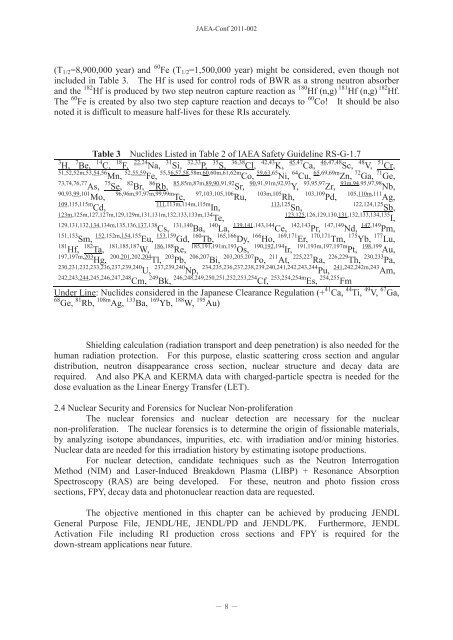JAEA-Conf 2011-002 - 日本原子力研究開発機構
JAEA-Conf 2011-002 - 日本原子力研究開発機構
JAEA-Conf 2011-002 - 日本原子力研究開発機構
You also want an ePaper? Increase the reach of your titles
YUMPU automatically turns print PDFs into web optimized ePapers that Google loves.
<strong>JAEA</strong>-<strong>Conf</strong> <strong>2011</strong>-<strong>002</strong><br />
(T1/2=8,900,000 year) and 60 Fe (T1/2=1,500,000 year) might be considered, even though not<br />
included in Table 3. The Hf is used for control rods of BWR as a strong neutron absorber<br />
and the 182 Hf is produced by two step neutron capture reaction as 180 Hf (n,g) 181 Hf (n,g) 182 Hf.<br />
The 60 Fe is created by also two step capture reaction and decays to 60 Co! It should be also<br />
noted it is difficult to measure half-lives for these RIs accurately.<br />
Table 3 Nuclides Listed in Table 2 of IAEA Safety Guideline RS-G-1.7<br />
3 H, 7 Be, 14 C, 18 F, 22,24 Na, 31 Si, 32,33 P, 35 S, 36,38 Cl, 42,43 K, 45,47 Ca, 46,47,48 Sc, 48 V, 51 Cr,<br />
51,52,52m,53,54,56 Mn, 52,55,59 Fe, 55,56,57,58,58m,60,60m,61,62m Co, 59,63,65 Ni, 64 Cu, 65,69,69m Zn, 72 Ga, 71 Ge,<br />
73,74,76,77 As, 75 Se, 82 Br, 86 Rb, 85,85m,87m,89,90,91,92 Sr, 90,91,91m,92,93 Y, 93,95,97 Zr, 93m,94,95,97,98 Nb,<br />
90,93,99,101<br />
Mo,<br />
96,96m,97,97m,99,99m<br />
Tc,<br />
97,103,105,106<br />
Ru,<br />
109,115,115m<br />
Cd,<br />
111,113m,114m,115m<br />
In,<br />
123m,125m,127,127m,129,129m,131,131m,132,133,133m,134<br />
Te,<br />
103m,105<br />
Rh,<br />
103,109<br />
Pd,<br />
105,110m,111<br />
Ag,<br />
113,125<br />
Sn,<br />
122,124,125<br />
Sb,<br />
123,125,126,129,130,131,132,133,134,135<br />
I,<br />
129,131,132,134,134m,135,136,137,138 Cs, 131,140 Ba, 140 La, 139,141,143,144 Ce, 142,143 Pr, 147,149 Nd, 147,149 Pm,<br />
151,153 Sm, 152,152m,154,155 Eu, 153,159 Gd, 160 Tb, 165,166 Dy, 166 Ho, 169,171 Er, 170,171 Tm, 175 Yb, 177 Lu,<br />
181 Hf, 182 Ta, 181,185,187 W, 186,188 Re, 185,191,191m,193 Os, 190,192,194 Ir, 191,193m,197,197m Pt, 198,199 Au,<br />
197,197m,203 Hg, 200,201,202,204 Tl, 203 Pb, 206,207 Bi, 203,205,207 Po, 211 At, 225,227 Ra, 226,229 Th, 230,233 Pa,<br />
230,231,232,233,236,237,239,240 U, 237,239,240 Np, 234,235,236,237,238,239,240,241,242,243,244 Pu, 241,242,242m,243 Am,<br />
242,243,244,245,246,247,248 Cm, 249 Bk, 246,248,249,250,251,252,253,254 Cf, 253,254,254m Es, 254,255 Fm<br />
Under Line: Nuclides considered in the Japanese Clearance Regulation (+ 41 Ca, 44 Ti, 49 V, 67 Ga,<br />
68 Ge, 81 Rb, 108m Ag, 133 Ba, 169 Yb, 188 W, 195 Au)<br />
Shielding calculation (radiation transport and deep penetration) is also needed for the<br />
human radiation protection. For this purpose, elastic scattering cross section and angular<br />
distribution, neutron disappearance cross section, nuclear structure and decay data are<br />
required. And also PKA and KERMA data with charged-particle spectra is needed for the<br />
dose evaluation as the Linear Energy Transfer (LET).<br />
2.4 Nuclear Security and Forensics for Nuclear Non-proliferation<br />
The nuclear forensics and nuclear detection are necessary for the nuclear<br />
non-proliferation. The nuclear forensics is to determine the origin of fissionable materials,<br />
by analyzing isotope abundances, impurities, etc. with irradiation and/or mining histories.<br />
Nuclear data are needed for this irradiation history by estimating isotope productions.<br />
For nuclear detection, candidate techniques such as the Neutron Interrogation<br />
Method (NIM) and Laser-Induced Breakdown Plasma (LIBP) + Resonance Absorption<br />
Spectroscopy (RAS) are being developed. For these, neutron and photo fission cross<br />
sections, FPY, decay data and photonuclear reaction data are requested.<br />
The objective mentioned in this chapter can be achieved by producing JENDL<br />
General Purpose File, JENDL/HE, JENDL/PD and JENDL/PK. Furthermore, JENDL<br />
Activation File including RI production cross sections and FPY is required for the<br />
down-stream applications near future.

















